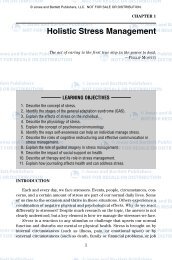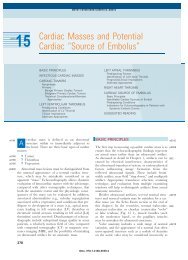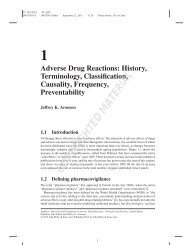Stability and Change in Industrial and Organizational ... - Axon
Stability and Change in Industrial and Organizational ... - Axon
Stability and Change in Industrial and Organizational ... - Axon
You also want an ePaper? Increase the reach of your titles
YUMPU automatically turns print PDFs into web optimized ePapers that Google loves.
orm_ch01.qxd 9/26/02 2:59 PM Page 12<br />
12 <strong>Stability</strong> <strong>and</strong> <strong>Change</strong> <strong>in</strong> <strong>Industrial</strong> <strong>and</strong> <strong>Organizational</strong> Psychology<br />
Hough <strong>and</strong> Furnham (this volume) review the burgeon<strong>in</strong>g<br />
literature on personality <strong>and</strong> the prediction of job performance.<br />
These authors make a good case for <strong>in</strong>creas<strong>in</strong>g the scientific<br />
underst<strong>and</strong><strong>in</strong>g of personality-performance l<strong>in</strong>ks by<br />
evaluat<strong>in</strong>g relations between relatively specific performance<br />
constructs <strong>and</strong> <strong>in</strong>dividual components of job performance.<br />
They also discuss alternative methods for measur<strong>in</strong>g personality,<br />
<strong>in</strong>clud<strong>in</strong>g the use of biodata, others’reports or descriptions,<br />
computerized assessment, <strong>and</strong> genetic test<strong>in</strong>g. Their position<br />
on the slant<strong>in</strong>g of responses or fak<strong>in</strong>g <strong>in</strong> a personnel selection<br />
context is that response distortion is not likely to affect validity<br />
substantially, although there is considerable disagreement<br />
on this topic (e.g., Rosse, Stecher, Miller, & Lev<strong>in</strong>, 1998).<br />
The approach to tra<strong>in</strong><strong>in</strong>g offered by Kraiger (this volume)<br />
reflects the major ways <strong>in</strong> which this area has been treated <strong>in</strong><br />
both theory <strong>and</strong> practice. Thus, tra<strong>in</strong><strong>in</strong>g does <strong>in</strong>volve both <strong>in</strong>struction<br />
<strong>and</strong> learn<strong>in</strong>g. However, it also is embedded <strong>in</strong> attempts<br />
to change the organization. In addition to detail<strong>in</strong>g<br />
these dist<strong>in</strong>ctions, the chapter goes on to highlight key issues<br />
<strong>in</strong> measurement that must be resolved if we are go<strong>in</strong>g to<br />
make great strides <strong>in</strong> this area.<br />
In their excellent chapter on utility, Boudreau <strong>and</strong><br />
Ramstad (this volume) go well beyond a review of cost-benefit<br />
analysis <strong>and</strong> th<strong>in</strong>k<strong>in</strong>g. These authors argue that <strong>in</strong>dustrial<br />
<strong>and</strong> organizational psychology must become more strategic<br />
to <strong>in</strong>fluence human resource decisions before such decisions<br />
are made rather than justify <strong>in</strong>terventions after the fact. They<br />
observe that there often exist <strong>in</strong> organizations key jobs that<br />
can create uniqueness <strong>and</strong> competitive advantage; <strong>and</strong> that<br />
these jobs are not necessarily the highest paid (e.g., trash<br />
sweepers at Disney World <strong>and</strong> repair technicians at Xerox).<br />
An implication of this chapter is that utility analysis should<br />
broaden from a rather esoteric technical topic to <strong>in</strong>clude an<br />
exam<strong>in</strong>ation of all l<strong>in</strong>ks between <strong>in</strong>vestments <strong>in</strong> <strong>in</strong>dustrial<br />
<strong>and</strong> organizational <strong>and</strong> <strong>in</strong> human resources (HR) programs<br />
<strong>and</strong> <strong>in</strong>dividual <strong>and</strong> organizational effectiveness.<br />
Extensive literatures on work motivation <strong>and</strong> job satisfaction<br />
are reviewed <strong>and</strong> organized <strong>in</strong> models that provide excellent<br />
frameworks for identify<strong>in</strong>g major themes <strong>and</strong><br />
po<strong>in</strong>t<strong>in</strong>g out gaps <strong>in</strong> our current knowledge. A chapter is devoted<br />
to each topic. Terence R. Mitchell <strong>and</strong> Denise Daniels<br />
(this volume) identify eight theoretical motivational positions<br />
(expectancy theory, self-efficacy, goal sett<strong>in</strong>g, moods<br />
<strong>and</strong> affect, need theories, dispositions, re<strong>in</strong>forcement theory,<br />
<strong>and</strong> justice). For each position, they review the progress to<br />
date <strong>and</strong> suggest new directions. All these positions are <strong>in</strong>troduced<br />
with<strong>in</strong> an overarch<strong>in</strong>g model that provides an excellent<br />
means for see<strong>in</strong>g the relationships among them. Hul<strong>in</strong> <strong>and</strong><br />
Judge (this volume), <strong>in</strong> their treatment of job satisfaction,<br />
also provide models that depict the nature of various posi-<br />
tions on job satisfaction. They use these models to show what<br />
has been found <strong>in</strong> the past, to discuss what we now know, <strong>and</strong><br />
to discuss some of the controversies that have been raised regard<strong>in</strong>g<br />
the nature of job satisfaction <strong>and</strong> its covariation with<br />
important behaviors at work.<br />
Avolio, Sosik, Jung, <strong>and</strong> Berson (this volume) do an excellent<br />
job of summariz<strong>in</strong>g the many crosscurrents <strong>in</strong> the field<br />
of organizational leadership. To their credit, they are also able<br />
to provide a synthesis around what they term a full-range theory<br />
of leadership. Although it rema<strong>in</strong>s to be seen if their approach<br />
will satisfy all of our needs, it does offer a very useful<br />
way to consider leadership as simultaneously an <strong>in</strong>put,<br />
process <strong>and</strong> output phenomenon—one that has been conceptualized<br />
as operat<strong>in</strong>g at several levels of analysis (e.g., dyad,<br />
team, unit, firm, <strong>and</strong> even nation-state). It also is <strong>in</strong>terest<strong>in</strong>g<br />
to note that the piece reflects the efforts of four generations<br />
of scholars who were able to f<strong>in</strong>d some common ground<br />
<strong>in</strong> produc<strong>in</strong>g this chapter <strong>in</strong> spite of the extensive <strong>and</strong> complex<br />
literature that exists.<br />
Although the <strong>in</strong>terplay between theory <strong>and</strong> practice can be<br />
found <strong>in</strong> several chapters, it is a major theme for Aust<strong>in</strong> <strong>and</strong><br />
Bartunek (this volume) on organizational development. The<br />
authors effectively show how theories of organizations <strong>and</strong><br />
theories of change comb<strong>in</strong>e to affect practice <strong>and</strong> the likelihood<br />
of favorable outcomes. They also go on to show how<br />
important it is to <strong>in</strong>tegrate knowledge from the field if we are<br />
go<strong>in</strong>g to have truly grounded theories of organizational dynamics<br />
<strong>and</strong> planned change.<br />
A topic that has enjoyed rapid development <strong>in</strong> the last<br />
decade or so is that of work teams <strong>and</strong> groups. Perhaps this<br />
phenomenon was due to a high level of fund<strong>in</strong>g for basic <strong>and</strong><br />
applied research <strong>in</strong> the United States by the military that has<br />
a great need to know about creat<strong>in</strong>g <strong>and</strong> manag<strong>in</strong>g effective<br />
comm<strong>and</strong> <strong>and</strong> control or action teams. It may have also been<br />
a result of a shift toward teams as a design solution for creat<strong>in</strong>g<br />
effective <strong>and</strong> adaptable work organizations. In any event,<br />
we <strong>in</strong> the field of <strong>in</strong>dustrial <strong>and</strong> organizational psychology<br />
are now able to underst<strong>and</strong> more than ever before just how<br />
<strong>and</strong> why work teams <strong>and</strong> groups function <strong>and</strong> can be made<br />
more effective. It is also fortunate that we have such a good<br />
summary of these developments <strong>in</strong> the chapter by Kozlowski<br />
<strong>and</strong> Bell (this volume). This chapter offers a unique multilevel<br />
perspective on how <strong>in</strong>dividuals, dyads, <strong>and</strong> teams function<br />
as nested systems. A signature feature of this chapter is<br />
the authors’ treatment of applied problematics (like staff<strong>in</strong>g<br />
<strong>and</strong> tra<strong>in</strong><strong>in</strong>g of teams) with<strong>in</strong> a conceptual framework that<br />
has been extensively <strong>in</strong>formed by research.<br />
Ryan <strong>and</strong> Ployhart (this volume), <strong>in</strong> their chapter about customer<br />
service behavior (CSB), use an <strong>in</strong>novative cont<strong>in</strong>gency<br />
approach to underst<strong>and</strong><strong>in</strong>g, predict<strong>in</strong>g, <strong>and</strong> <strong>in</strong>fluenc<strong>in</strong>g CSB.
















